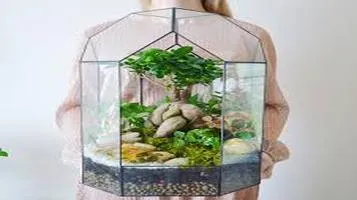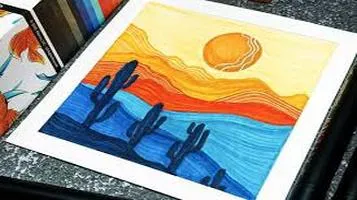Geometric Terrariums: A Fusion of Nature and Art
Geometric terrariums are stylish and modern containers used to house small plants, typically succulents, cacti, or air plants. Characterized by their angular, multifaceted designs, these terrariums are often made from glass panels held together by metal frames, creating a sleek, contemporary look. Their geometric shapes, such as cubes, pyramids, or dodecahedrons, not only serve as eye-catching decorative pieces but also provide an enclosed environment that helps maintain humidity and warmth for the plants inside. These terrariums are perfect for small spaces, bringing a touch of nature indoors without requiring extensive maintenance. Ideal for both homes and offices, geometric terrariums add a sense of tranquility and elegance, making them a popular choice for interior decoration and gifting.

In recent years, the resurgence of indoor gardening and the growing appreciation for minimalist décor have given rise to a fascinating trend: geometric terrariums. These exquisite glass containers, often fashioned into intriguing shapes like pentagons, hexagons, and octahedrons, have captivated the hearts of design enthusiasts and plant lovers alike. Combining the elegance of modern design with the timeless beauty of nature, geometric terrariums offer an innovative way to bring the outdoors in. Here’s an in-depth look at why these captivating structures have become a staple in contemporary interiors.
Aesthetics and Design
Geometric terrariums are, first and foremost, a visual delight. Their clean lines and symmetrical forms create a striking contrast with the organic shapes of the plants they house. The juxtaposition of the rigid glass framework against the soft, verdant greenery results in a harmonious blend of man-made and natural elements. This balance makes them a versatile addition to any space, from ultra-modern apartments to cozy, rustic homes.
The variety of shapes available means there is a geometric terrarium to suit every taste. Whether you prefer the classic elegance of a dodecahedron or the futuristic appeal of a tetrahedron, these terrariums can be customized to match your aesthetic preferences. The transparency of the glass also allows for a 360-degree view of the plants inside, making them a dynamic focal point in any room.
Versatility and Functionality
One of the standout features of geometric terrariums is their versatility. They can be used to house a wide range of plants, from succulents and cacti to ferns and air plants. This adaptability makes them an excellent choice for both novice and experienced gardeners. For those new to indoor gardening, succulents and cacti are particularly well-suited to terrariums due to their low maintenance requirements and resilience.
Moreover, geometric terrariums are not just limited to plant life. They can also serve as creative containers for decorative items such as candles, fairy lights, or even small sculptures. This multifunctionality allows you to change their contents according to seasons or personal whims, ensuring that they remain a fresh and engaging element of your décor.
Ease of Maintenance
One of the most appealing aspects of geometric terrariums is their low maintenance requirements. The enclosed environment helps to regulate humidity and reduce the amount of watering needed, making them an ideal option for busy individuals or those who may not have a natural green thumb. Most terrariums only require occasional watering and pruning to keep the plants healthy and vibrant.
The glass surfaces are easy to clean, ensuring that your terrarium always looks its best. Simply wiping the glass with a damp cloth can remove any dust or smudges, keeping the structure clear and the plants visible. Additionally, the sturdy construction of these terrariums means they are built to last, offering a long-term solution for your indoor gardening needs.
Environmental Benefits
In addition to their aesthetic and functional advantages, geometric terrariums also offer several environmental benefits. By bringing plants indoors, they help to improve air quality by absorbing carbon dioxide and releasing oxygen. Many plants commonly used in terrariums, such as ferns and spider plants, are known for their air-purifying properties, helping to remove toxins and create a healthier living environment.
Furthermore, the use of terrariums encourages a more sustainable lifestyle by promoting the care and appreciation of living plants. Unlike cut flowers, which have a limited lifespan, terrarium plants can thrive for years with proper care. This longevity reduces waste and supports a more eco-friendly approach to home décor.
Personalization and Creativity
Geometric terrariums offer endless opportunities for personalization and creativity. From choosing the type and arrangement of plants to adding decorative elements like colored sand, pebbles, or miniature figurines, you can create a unique and personalized piece that reflects your style and personality. This creative aspect makes them an excellent project for DIY enthusiasts and a thoughtful gift for friends and family.
For those who enjoy a hands-on approach, assembling a geometric terrarium can be a deeply satisfying and meditative activity. The process of selecting plants, arranging them within the glass container, and watching them grow over time can provide a sense of accomplishment and connection to nature.
Conclusion
In summary, geometric terrariums are more than just a passing trend; they represent a beautiful and functional fusion of art and nature. Their striking designs, versatility, ease of maintenance, and environmental benefits make them a worthy addition to any home or office. Whether you are an experienced gardener or a novice looking to dip your toes into the world of indoor plants, a geometric terrarium offers a stylish and sustainable way to bring a touch of greenery into your life. With endless possibilities for personalization, these elegant structures are sure to captivate and inspire for years to come.






